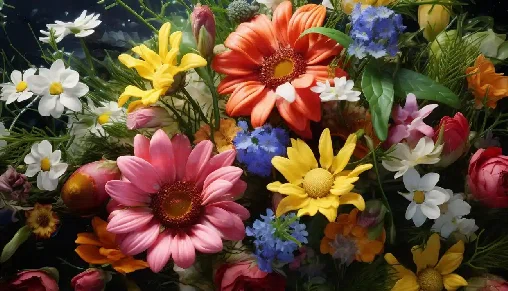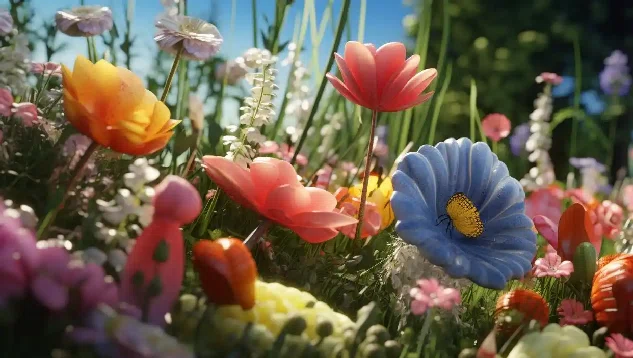When it comes to flower language, different cultures and regions may assign different meanings to flowers. Here are 100 common flowers and their flower language in general: 1. Rose - Love, Passion, and Beauty. Roses of different colors have different floral languages: red represents passionate love, white represents purity and innocence, yellow represents friendship, pink represents joy, and purple represents mystery.
1. Rose - Love, Passion, and Beauty. Roses of different colors have different floral languages: red represents passionate love, white represents purity and innocence, yellow represents friendship, pink represents joy, and purple represents mystery.
2. Sunflowers - hope, sunshine, happiness. Sunflowers represent a positive attitude towards life and a happy mood.
3. Tulip - Deep affection, warmth, and beauty. The language of tulips represents deep affection and sincere emotions. 4. Lily - pure, noble, and elegant. Lily flowers are often associated with purity and nobility, and are also common flowers at weddings. 5. Carnations - maternal love, care, and gratitude. Carnations represent a mother's love and gratitude. 6. Hyacinth - gentle, sweet, and fulfilling. Hyacinth is a flower that represents happiness and beauty.
7. Lily of the valley - purity, happiness, and blessings. The bell orchid represents pure love and blessings.
8. Peony - Wealth, glory, and grace. Peony is the national flower of China, representing wealth and glory.
9. Green embroidered ball - hope, wait, miss. Blue embroidered balls are usually given to people when they are waiting and missing.
10. Peony - Beautiful, shy, shy. Peonies represent the emotions of beauty and shyness.
11. Starry Sky - Love, Happiness, Dreams. Starry sky is a small flower that represents love and happiness.
12. Don't forget me - eternal love and memory. Don't forget that I usually give gifts to those who are deeply missed. 13. Honeysuckle - Health, longevity, and happiness. Honeysuckle is a herbaceous plant that symbolizes longevity and health.
14. Shizhu - Deep affection, gratitude, and sincerity. Shizhu flower represents deep affection and sincerity.
15. Lilac - Beautiful memories and longing. Lilacs are flowers that express longing and beautiful memories. 16. Platycodon grandiflorum - hope, tranquility, and contemplation. The bellflower usually symbolizes hope and introspection. 17. Blue Snowflake - calm, peaceful, and clean. Blue snowflakes represent calmness and cleanliness. 18. Horseshoe Lotus - Hope, purity, and beauty. The horseshoe lotus represents hope and purity.
19. Cuiju - Loyalty, Friendship, and Happiness. Chrysanthemums are usually given as gifts to people who express friendship and loyalty.
20. Magnolia - Noble, pure, and dignified. Magnolia represents nobility and dignity.
21. Chrysanthemums - longevity, happiness, and friendship. Chrysanthemums of different colors have different floral meanings, but overall they symbolize friendship and longevity. 22. Lavender - calm, peaceful, and relaxing. Lavender is commonly used to represent calmness and tranquility. 23. Bellflower - noisy, joyful, and lively. Bellflower symbolizes joy and liveliness. 24. Iris - Noble, Noble, and Free. Iris represents nobility and freedom.
25. Xuancao - hope, wait, miss. Xuancao is usually given to people during waiting and longing. 26. Mandala - Charm 27. Violet - Humility, prudence, and chastity. Violet symbolizes humility and loyalty. 28. Magnolia flowers - pure, noble, and elegant. Magnolia is a noble flower. 29. Lilac - Love, Waiting, Promise. Lilac represents waiting and commitment.
30. Three colored violet - thoughts, longing, and happiness. Three colored pansies are usually given as gifts to people who express their longing and happiness. 31. Cockscomb flower - passion, courage, and happiness. The cockscomb flower represents passion and courage.
32. Dandelion - happiness, hope, and wishes. Dandelions are usually used to express wishes and hopes.
33. Hibiscus - elegant, pure, and noble. Hibiscus represents elegance and purity.
34. Mustard flower - provocative, enthusiastic, and confident. Mustard flowers represent provocation and confidence.
35. Rhododendron - Freedom, Love, Hope. Rhododendrons usually symbolize freedom and hope.
36. Dahlia - Unforgettable and Missing. Dahlia is usually used to express unforgettable memories and longing. 37. Jade Hairpin - Pure, Happy, and Innocent. Jade hairpin usually represents purity and innocence.
38. Rehmannia glutinosa - Warning, Caution, Alert. Mao Di Huang Hua has a warning and alert flower language. 39. Morning glory - the flame and passion of love. Morning glory represents the passion of love.
40. Muxiang - missing, thinking, and contemplation. Muxiang flowers are usually used to express thoughts and contemplation.
41. Rapeseed flowers - beauty, hope, happiness. Rapeseed flowers are usually used to represent hope and happiness.
42. Iron Tie Lian - Strong, indomitable, and determined. Iron wire lotus represents strength and determination.
43. Persimmon - Deep affection, love, true love. Persimmon is usually used to express deep affection and true love. 44. Zhu Ding Hong - Passionate, festive, and joyful. Red flowers with red tops symbolize joy and happiness. 45. Jasmine - shy, pure, and gentle. Jasmine flowers are usually used to express feelings of shyness and tenderness. 46. Purple Red Jing - Hope, Blessings, and Happiness. Purple red wisteria flowers are usually used to express wishes and happiness. 47. Gold and Silver Chrysanthemum - Love, Friendship, Sincerity. Chrysanthemums are usually used to express love and sincerity. 48. Goldfish Grass - Beautiful, joyful, and entertaining. Goldfish grass represents joy and entertainment.
49. Radish flowers - hope, prosperity, and abundance. Radish flowers are usually used to express hope and prosperity.
 50. Calendula - Eternal Love and Blessings. Calendula represents eternal love and wishes. 51. Lotus - pure, noble, and perfect. Lotus flowers usually symbolize purity and perfection. 52. Fragrant Snow Orchid - gentle, pure, and sincere. Xiangxuelan is usually used to express tenderness and sincerity.
50. Calendula - Eternal Love and Blessings. Calendula represents eternal love and wishes. 51. Lotus - pure, noble, and perfect. Lotus flowers usually symbolize purity and perfection. 52. Fragrant Snow Orchid - gentle, pure, and sincere. Xiangxuelan is usually used to express tenderness and sincerity. 53. Peach Blossoms - Love. 54. Rose - Beautiful. 55. Cuizhu - Tranquil, peaceful, and wise. The emerald bamboo flower is usually used to represent tranquility and wisdom. 56. Acorus calamus - Brave, confident, and unrestrained. Iris flowers are usually used to express bravery and confidence. 57. Cherry Blossoms - Beautiful, Short, and Farewell. Cherry blossoms are beautiful but short-lived flowers, often associated with parting. 58. Garlic - Warning, Vigilance, Vigilance. Garlic flowers have warning language. 59. Strawberry Flowers - Desire, Temptation, Love. Strawberry flowers are usually used to express desire and temptation.
60. Champagne Roses - Congratulations, Celebration, and Joy. Champagne roses are usually used to express celebration and joy. 61. Daisy - Pure, selfless, and childlike. Daisy usually symbolizes purity and innocence. 62. White Orchid - Pure. 63. Bauhinia - Hope.
64. Sunflower - passionate, joyful, and loyal. Sunflowers represent passion and joy. 65. Lavender - Tranquil, peaceful, and relaxing. Lavender is usually used to indicate calmness and relaxation. 66. Munchki - Unpredictable and mysterious. Munchki flowers usually have mysterious floral language.
67. Thick skin fragrance - deep affection,
passionate, true love.
. Thick skinned fragrant flowers are usually used to express deep affection and true love. 68. Xianke Lai - Surprise, Miracle, and Magic. Fairy flowers symbolize surprise and wonder. 69. Sophora flavescens - Strong, stubborn, and persistent. Kushen flower represents strength and perseverance. 70. cornflower - loyalty. 71. Five willows - hope, longevity, and resilience. Five willows are usually used to express hope and resilience. 72. Chandelier - mysterious, luxurious, and elegant. The pendant lamp flower symbolizes mystery and luxury. 73. Bluetooth Flower - Silence, Communication, and Communication. Bluetooth flowers are commonly used to indicate silence and communication. 74. Plum Blossom - Hope. 75. Cotton Flowers - Persist. 76. Wild Rose - Passionate. 77. Tianzhu - Poverty Alleviation. 78. Cowtail Grass - Honesty, resilience, and strength. Oxtail grass flower represents honesty and strength. 79. Fir - perseverance, tenacity, and endurance. The fir flower is usually used to indicate persistence and patience. 80. Turtle Back - perseverance, tolerance, and peace. The turtle's back flower represents perseverance and peace. 81. Shi Nan - Brave, resilient, and determined. The heather flower symbolizes bravery and determination. 82. Bitter cauliflower - setbacks, difficulties, resilience. Bitter cauliflower is usually used to represent setbacks and resilience. 83. White Rose - Pure, Innocent, and True. White roses represent purity and authenticity.84. Red roses - passion, love, joy. Red roses represent passion and love. 85. Yellow Rose - Friendship, Joy, and Tolerance. Yellow roses represent friendship and tolerance. 86. Orange Rose - Joy, Desire, Passion. Orange roses represent joy and passion. 87. Purple Rose - Mystery, passionate love, dream. Purple roses represent mystery and passion. 88. Blue Rose - Mysterious, impossible, and unreal. Blue roses represent mystery and unreality. 89. Rosebud - Waiting, Hope, Love. Rose buds are usually used to indicate waiting and hope. 90. Rose Leaves - Beethoven's Love and Music. Rose leaves represent music and Beethoven's love. 91. Shamgrass - calm, tolerant, and humble. Shamgrass is usually used to express peace and humility. 92. Aiju - Courage, Protection, Loyalty. Aiju is usually used to express courage and loyalty. 93. Reed - flexible, resilient, and hopeful. Reed is usually used to represent flexibility and hope. 94. Beibei - Strong, tolerant, and kind. Beibei flower represents strength and kindness. 95. Antelope Flower - Lightweight. 96. Sunflower - Hope, sunshine, happiness. Sunflowers are usually used to express hope and happiness. 97. Rose Vine - Lifetime Loyalty, Eternal Love. Rose vine flowers represent lifelong loyalty and eternal love. 98. Rose bouquet - love, gratitude, praise. Rose bouquets are usually used to express love and gratitude. 99. Yellow Orange Rose - Joy, Sunshine, and Happiness. Yellow orange roses represent joy and happiness. 100. Black Rose - sadness, farewell, and loss. Black roses are often associated with sadness, farewell, and loss.